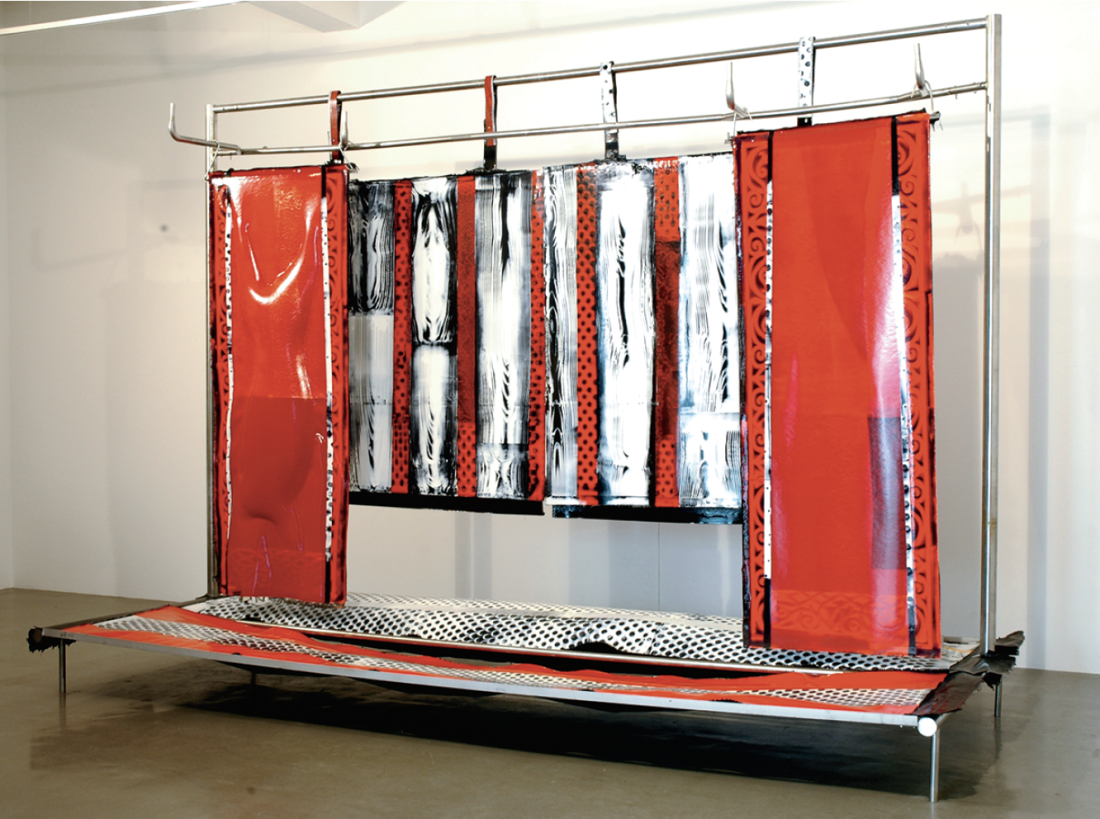Clay Ellis

Clay Ellis, Tinney’s Flat, 2005, acrylic, polyurethane, stainless steel, looped video projection, MDF, barbed wire, gauze fabric, 9’ 2” x 8’ 2” x 16’ 2”. Photo: C. Ellis. Courtesy the artist.
On a sunny day in London, England, I was overwhelmed by the natural light streaming into the atrium entrance of the APT Gallery located in Deptford, an area on the south bank of the River Thames in southeast London. The work Remittance Man / 3rd Winter, 2005, by Edmonton sculptor Clay Ellis twinkled in this front room, simultaneously shifting and concealing, and playing tantalizing tricks. Set askew in the space, this aluminum tent-like structure has, suspended from its frame, various sized square and rectangular polyurethane panels, painted with a dizzying pattern of black dots that were blurred over a creamy white surface. Although quite substantial, each tarp is edged with delicate fringes that not only speak to the process of creating but also imbue the work with a sense of fragility.
Ellis notes that the reference to dots, which also appear in the other works, comes from the lace curtains that hung in his grandmother’s house. As a child, the artist was surrounded by the desolate landscape of Southern Alberta and the brute roughness of his family’s fourth-generation cattle ranch. Yet Ellis was aware of the small attempts to humanize and soften this reality with elements like delicate curtains that disguised but never really covered up what was happening inside and outside the home.
It is difficult to categorize Ellis’s works since they exist between painting and three-dimensional form, object and idea. The exhibition is composed of three major pieces paired with a triad of historical film footage documenting activities on the cattle ranch such as branding, wrangling and castrating. Each activity is carried out by one of Ellis’s male relatives and is layered with decorative patternings that cover the surfaces of his three-dimensional pieces.
Tinney’s Flat, 2005, incorporates contemporary images of present-day cattle ranching as a looped video sequence that is projected over an impressive stack of spools of barbed wire (eight miles to be exact) draped in a gauzy white fabric. Acting as a metaphor for habitation, the work’s appearance is intimidating. Taking its reference point from wind shelters for cattle, the piece oscillates between containment and escape. This inside/outside feeling is further heightened by the polished stainless steel fencing that hangs on the gallery wall in the same sequence as the structure’s blue and white wood grained slats (also backed in stainless steel). The resulting reflections in the material create an ambiguity regarding where the sculpture begins and ends. It also increases the tension of looking and watching; as you watch yourself, you watch others, all the while simultaneously watching the looped projection. The video sequence acts as a form of experience. The images, although actual, become exaggerated in the mind and memory as they collectively stand in for a sense of history and place. These references, so personal to Ellis, are at the same time distanced from our contemporary urban understanding of where the meat we consume comes from.

Clay Ellis, The Walker’s Place, 2005, acrylic, polyurethane, stainless steel, 11’ 2” x 5’ 5” x 16’ 4”. Photo: C. Ellis. Courtesy the artist.
Recalling a monumental classical stone frieze or stretching out like a Japanese kimono on display is The Walker’s Place, 2005, which commands the far space at the end of the gallery. Striking panels like skins are suspended from a particularly matter-of-fact structure that sports a series of serious looking hooks. As we move up to the piece, it becomes apparent that these tarps are bloated, bulbous forms, which effectively has them read as carcasses, hung to bleed out, to be butchered and processed. This work borrows elements like the wood grain and polka dots, as well as the tension of gravity, from the other pieces, but its scale and scarlet red colour firmly stake its commanding presence.
Ellis’s exhibition is about filtering experience and creating the objects that become the medium of ideas. Memory plays a significant role; negating truth, it constructs understanding, both personal and collective. It is the tension between lived realities and making sense of the meaning of that reality that carries Ellis’s work into a space for contemplation through questioning and exposing the raw facts of growing up and living in the “West.” ❚
“Eight Miles of Barbed Wire,” curated by Karen Wilkin, was exhibited at apt Gallery, London, England, from April 9 to 26, 2009, and was supported, in part, by the Alberta Foundation for the Arts. This exhibition project was originally commissioned for the opening of the Esplanade Art Gallery, Medicine Hat, Alberta, that occurred in October 2005.
Mary Reid is the curator of contemporary art and photography at the Winnipeg Art Gallery.

